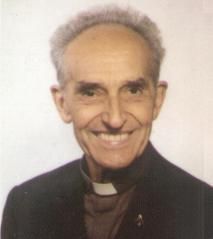Daniel Comboni
Comboni Missionaries
Institutional area
Other links
Newsletter
In Pace Christi
Centis Felice Teodoro
Fr. Felice Teodoro Centis was born at Gleris di San Vito al Tagliamento, in the province of Pordenone, on 12 April, 1919, of Sante e Augusta Chiarotto.
His missionary vocation originated with the visit of the young missionary Fr. Angelo Tarantino, in March, 1933, to the seminary of Pordenone, where Felice was in the third year of the gymnasium. On that occasion, as he recalled many years later, Fr. Angelo “opened his mind and heart to pagan lands”.
Thus, “still interested in Africa and especially in Uganda”, at Easter of 1941, Felice applied to Mgr. Luigi Paulini for permission to enter the Comboni novitiate at Venegono to complete his studies, while still remaining incardinated in the diocese up to his final vows. Permission was duly granted and he was ordained priest on 3 June, 1943, and took final vows on 7 October, 1946.
In May of the same year, together with four confreres, he was sent to London for the obligatory “English Year” in preparation for Uganda, as required by the colonial authorities for African countries under their jurisdiction.
After Christmas of 1947, Fr. Antonio Todesco reopened the Sunningdale house with part of it as a novitiate and part as a middle school. Fr. Felice was placed in charge of the latter. Two years later, Stillington was opened in Yorkshire and Fr. Felice was sent there as superior. In September 1953, an annoying backache that had troubled him for two years led the superiors to decide not to send him to the mission but to Dawson Place in London, where he stayed for seven years. Fr Felice became editor of Our African Missions, the bi-monthly magazine of the English Province, which he renamed Verona Fathers’ Missions two years later.
In 1961 he was again sent to Sunningdale as superior and rector of both novices and scholastics. He had plans drawn up for enlarging the house with a new wing for scholastics and a new church. Both were inaugurated in 1964.
In October, 1963, he was transferred to Allanton in Scotland for mission promotion.
In September 1967, he was at last assigned to Uganda. In October he arrived at Arua where, after 34 years, that is, since his seminary days, he met again Mgr. Tarantino, now a bishop. Fr. Felice was sent to the mission of Paidha, in West Nile. In July, 1974, he was transferred to Ombaci as chaplain and teacher in the school.
He was elected delegate to the General Chapter of 1975 and left Ombaci in May of the same year. Once the Chapter was over, the then Superior General, Fr. Tarcisio Agostoni, called him to the Curia as General Secretary. From November 1975 to July 1982, he was engaged in a sort of missionary work he never contemplated and endeavoured to carry it out diligently. We owe him the improvement of the cataloguing system used in the Curia and the present layout of the Annuario Comboniano. In October 1982 he was urgently admitted to the Italian hospital, London, where he was doing a short course at the MIL.
After a period of convalescence, he returned to Uganda in April, 1983, at the age of 64, and was appointed to Warr. He assisted in the handover of the two parishes of Warr e Zeu to the diocese. He then went to Angal (Nebbi Diocese), where he became parish priest, also engaged in the extension of the catechetical centre.
An initiative of his in the field of evangelisation and human promotion of the populations who lived in poverty on the banks of Lake Albert is worth mentioning, namely the translation of the Bible into Alur, a language spoken by one million people. It was a gigantic task which took up as many as fifteen years of his “free time” and which was followed by other translations of liturgical, catechetical and scholastic books. In November 1989, Fr. Felice was transferred to Parombo as curate to the parish priest Fr. Elio Zanei, but also with the task of continuing the translation and printing of liturgical texts. The great dedication he exercised in that task, which occupied him until some hours before his death, is well known.
In 1999, he returned to Angal where he spent the rest of his life. In 2010, he had to stay at Verona Mother House for treatment and succeeded in returning to Angal in August, 2011, intending to die among the people he loved and by whom he, in turn, was loved. Last December he wrote: “Our good people received me with festivity. May the Lord give me the grace to prepare well for the encounter with him. Time is short and the end is near”.
He died at Angal on 10 March, 2012. After the funeral rites, he was buried, as he had hoped and asked of his superiors, in the cemetery of the mission of Angal, in the land of Africa he loved so much.

